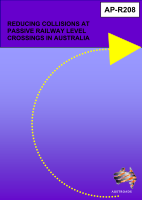Road Safety

Reducing Collisions at Passive Railway Level Crossings in Australia
- Publication no: AP-R208-02
- ISBN: 0 85588 629 3
- Published: 30 August 2002
- PDF (free) Download
This report examines safety at passive railway crossings in Australia, in response to a request from the Australian Transport Council. It is estimated that there are 6,000 railway crossings in Australia without active systems to signal the approach of a train, and there is currently no cost-effective method of converting these to active crossings. The project involved the collection and collation of information on State policies, guidelines and initiatives relating to passive railway crossings with the aim of identifying best practice solutions to reducing collision risk at passive railway crossings. The project notes that Australia has a lower population rate of collisions at passive railway crossings than other comparable countries. It makes a number of recommendations including improved data collection and better linkages between existing road crash and rail crossing data systems, improved signage and road markings, train lighting and reflective materials, public education, proactive risk management, and further investigation of the potential for developing lower cost active treatments. The report concludes that passive railway crossings may not be appropriate on lines used by high-speed trains and recommends the wider use of active crossings on such lines. The report recommends guidelines for ensuring good practice in managing risk at passive railway crossings.
- Executive Summary
- . Recommendations
- 12.1. Data issues
- 12.2. Possible changes to the Australian Standard for road signs and markings atrailway level crossings.
- 12.3. Proactive risk management
- 12.4. Train lighting and reflective materials
- 12.5. Lower cost active treatments
- 12.6. Education
- 12.7. Limitations of passive crossings
- 12.8. Good practice in managing risk at passive crossings
- 1. INTRODUCTION
- 1.1. Background
- 1.2. The project
- 1.3. The process
- 2. CRASHES AT PASSIVE RAILWAY CROSSINGS IN AUSTRALIA
- 3. HOW DOES AUSTRALIA’S CRASH OUTCOME COMPARE?
- 4. CURRENT PRACTICE FOR SIGNING PASSIVE RAILWAY CROSSINGSIN AUSTRALIA AND NEW ZEALAND
- 4.1. Signing and marking
- 4.2. Rumble Strips
- 4.3. Harmonisation Of Standards
- 4.4. Managing risks at passive level crossings
- 5. TREATING RAILWAY LOCOMOTIVES AND ROLLING STOCK
- 5.1. Auxiliary lighting on locomotives
- 5.2. Reflectorised material on rolling stock
- 5.3. Audible signals
- 6. LOW-COST ACTIVE TREATMENT
- 7. OTHER INTELLIGENT TRANSPORT SYSTEMS SOLUTIONS
- 8. EDUCATION
- 9. GOOD PRACTICE IN MANAGING RISK AT PASSIVE RAILWAY LEVELCROSSINGS
- 10. ISSUES FOR THE FUTURE
- 11. CONCLUSIONS
- 12. RECOMMENDATIONS
- REFERENCES
- Appendix A: Comparison of Warrants for Level Crossing Protection – Australia and New Zealand
- APPENDIX B: The Queensland Risk Based Scoring System
Related publications
WEB-ZRT-24
Latest Road Safety News
